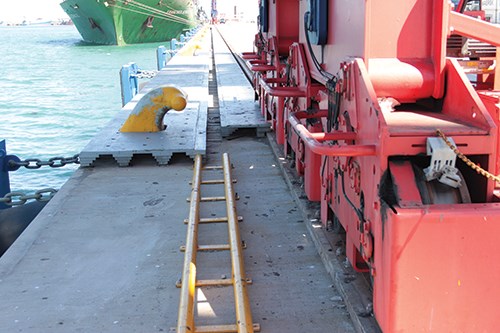Quay cable tray: Composites upgrade container ship terminal
When the Cape Town, South Africa, Transnet National Ports Authority began a 12-month effort to expand its facility and upgrade its existing quays (wharfs), engineers realized that the Authority had a safety problem at its main container quay. Composites provided the solution.
In South Africa, the Transnet National Ports Authority of Cape Town operates a busy port with considerable container ship traffic. When it began a 12-month effort with a local civil engineering company to expand its facility and upgrade its existing quays (wharfs), engineers realized that the Authority had a safety problem at its main container quay: A raised cable tray runs along the quay’s edge. More than 1,200m/3,900 ft long and 3m/10 ft wide, the tray contains the electrical cables that power the large, rail-mounted gantry cranes used to load and unload ships. The tray was a serious trip hazard for workers. In search of a safer solution, the engineering company approached Cape Town-based composite materials supplier and distributor AERONTEC cc.
“Engineers had considered pouring a concrete layer at 190 mm [7.5 inches] thick to bring the quay edge level with the cable tray and the crane rail,” says Graham Blyth, Aerontec’s owner. But that solution weighed in at about 1,000 tons, he recalls. The quay’s cantilevered deck and supporting piles weren’t designed to carry the additional weight. Further, he notes, the concrete’s “28-day cure time would have interfered with berthing ships.”
The cable tray problem needed a solution that would be not only light in weight, but also provide safe footing and permit access to existing manholes and fire hydrants, yet be cost-effective and easy to install. The Ports Authority further specified that any seawater that might wash over the installation should drain away quickly, with minimal corrosion. Perhaps the toughest requirement, however, was that the solution should be strong enough to bear loads of up to 36.3 metric tonnes (80,028 lb) in the event a shipping container is placed, or dropped, within the cable tray area. Finally, the structure should be replaceable, if damaged, and prevent damage to the quay’s underlying concrete surface.
An iterative design and testing process resulted in large, monolithic resin-infused, fiberglass-reinforced polymer (FRP) panels. The 32-mm/1.5-inch thick slabs, formed from woven glass roving and isophthalic polyester resin, were coated with a UV-stabilized iso-NPG (neopentyl glycol) and a nonslip grip finish and drilled to create drainage holes. The reinforcement was woven to Aerontec’s specification and supplied by Vision Composites (Winchester, U.K.) The resin, gel coat and flow-coating materials were sourced from two suppliers: NCS Resins (Pinetown, South Africa) and Scott Bader Company Ltd.(Northamptonshire, U.K.). Aerontec partnered with composites fabricator MMS Technology (Centurion, South Africa) to manufacture and waterjet cut 1,161 panels of varying sizes, which were numbered for installation. Blyth explains that each panel was raised to the specified height using stepped solid feet, bonded to the panel underside; the stepped feet were cored with a vertical pultruded FRP rod. “The quay varies 80 mm [3.2 inches] in height over its surface,” he points out. “We needed to be virtually level with the crane rail to eliminate any trip hazard, so we bonded GFRP shims to the stepped feet to keep the panels level,” he adds.
Some panels required cutting to accommodate the quay bollards (thick, yellow curved posts in photos), and in other panels, openings were cut and fitted with hinged lids for manhole/fire hydrant access. A 300-mm/12-inch gap was left between the panels adjacent to the crane rail and the panels at the water’s edge, to accommodate the crane’s electrical cables. A stiff rubber “Panzer” belt covers the gap, and the cranes are fitted with onboard lifters that bend the belt up out of the way as the crane rolls through on the rails (see the middle photo).
The total weight of all the composite panels was just 226 metric tonnes (500,000 lb) — within the quay’s weight constraint — and the entire project was completed on schedule and within budget.
“As far as I know, this is the first time a project of this type has ever been undertaken in the world,” concludes Blyth. “And I believe it was also the biggest single composites job ever completed in South Africa.”
Related Content
JEC World 2022, Part 1: Highlights in sustainable, digital, industrialized composites
JEC World 2022 offered numerous new developments in composites materials, processes and applications, according to CW senior editor, Ginger Gardiner, most targeting improved sustainability for wider applications.
Read MoreCarbon fiber in pressure vessels for hydrogen
The emerging H2 economy drives tank development for aircraft, ships and gas transport.
Read MoreAdvanced Fiberglass Industries: Composites enable innovation
With decades of composites design and fabrication experience, Dubai-based AFI turns problems into solutions.
Read MoreMaterials & Processes: Resin matrices for composites
The matrix binds the fiber reinforcement, gives the composite component its shape and determines its surface quality. A composite matrix may be a polymer, ceramic, metal or carbon. Here’s a guide to selection.
Read MoreRead Next
CW’s 2024 Top Shops survey offers new approach to benchmarking
Respondents that complete the survey by April 30, 2024, have the chance to be recognized as an honoree.
Read MoreFrom the CW Archives: The tale of the thermoplastic cryotank
In 2006, guest columnist Bob Hartunian related the story of his efforts two decades prior, while at McDonnell Douglas, to develop a thermoplastic composite crytank for hydrogen storage. He learned a lot of lessons.
Read MoreComposites end markets: Energy (2024)
Composites are used widely in oil/gas, wind and other renewable energy applications. Despite market challenges, growth potential and innovation for composites continue.
Read More















.jpg;maxWidth=300;quality=90)












